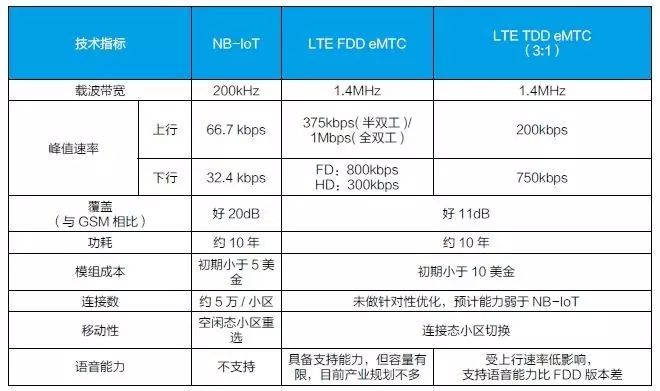Abstract: This article systematically reviews and analyzes the main performance of NB-IoT and eMTC in ten aspects. After ten rounds of debate, let us re-examine what the best decision for China Mobile should be.

| Technology | Miscellaneous Talks |
China’s leading self-media in the telecommunications industry

Wang Feng has experience working in telecommunications at the group, provincial, municipal, and county levels, focusing on ICT, mobile internet, and new media, researching from a storytelling perspective and reading industry trends with a research logic.
Unicom’s mixed reform: a lifesaver or a poison pill?
The three gray rhinos behind China Mobile’s impressive achievements
How countries around the world are betting on smart manufacturing
A historic industrial migration
 Technology Miscellaneous Talks: keji_zatan Long press the QR code to view more historical articles by Wang Feng
Technology Miscellaneous Talks: keji_zatan Long press the QR code to view more historical articles by Wang Feng
With the continuous development of mobile communication technology, the global Internet of Things is about to usher in rapid development. Among international operators, AT&T, Verizon, KDDI, KPN, Orange, NTT DoCoMo, Telefonica, Telstra, and Telus have all launched commercial eMTC.
In China, telecom operators took the lead, having established 800MHz networking capabilities, and are set to build 300,000 NB-IoT base stations in one go. Unicom signed a dual-exclusive agreement with Jasper, early on determining NB-IoT as its development direction.
However, China Mobile, which proposed the idea first, has been indecisive between NB-IoT and eMTC. The main reason for this indecision is that both standards have their strengths, and China Mobile’s TDD network complicates its decision-making.
This article systematically reviews and analyzes the main performance of NB-IoT and eMTC in ten aspects. After ten rounds of debate, let us re-examine what the best decision for China Mobile should be.
1. Choosing the Battlefield
In the construction of the Internet of Things, there are many application scenarios that need to be met. So, in which scenarios do NB-IoT and eMTC compete? There are mainly three scenarios, let’s take a look at them one by one.
IoT applications can be divided into three main categories based on requirements for rate, latency, and reliability:
Scenario 1: Low latency, high reliability services. This type of service has high requirements for throughput, latency, or reliability, with typical applications including vehicle networking and remote medical services;
Scenario 2: Medium demand services. This type of service has moderate or low throughput requirements, with some applications requiring mobility and voice, and also having certain limitations on coverage and cost. Typical services include smart home security and wearable devices;
Scenario 3: LPWA (Low Power Wide Area) services. The main characteristics of LPWA services include low power consumption, low cost, low throughput, wide (deep) coverage, and a large number of involved terminals. Typical applications include meter reading, environmental monitoring, logistics, and asset tracking.
Among the above types of services, LPWA services are the main market for global operators to compete for connections due to the large scale of connection demands. NB-IoT and eMTC mainly compete in this battlefield.
2. Which Competitors Were Defeated
As NB-IoT and eMTC have progressed, which network standards have they defeated to reach the final stage?
Currently, there are various IoT communication technologies that can support LPWA services, such as GPRS, LTE, LoRa, Sigfox, etc., but they have the following issues:
1. Terminal battery life cannot meet requirements. For example, the current GSM terminal standby time (excluding business) is only about 20 days. In some typical LPWA applications, such as meter reading, the cost of replacing batteries is high, and in certain special locations, such as deep wells and chimneys, replacing batteries is very inconvenient.
2. Unable to meet the application demands of massive terminals. A major characteristic of IoT terminals is their massive scale, so the network needs to support a large number of users simultaneously. However, networks designed for non-IoT applications cannot meet the demand for simultaneous access of massive terminals.
3. Insufficient network coverage in typical scenarios, such as deep wells and underground garages, where coverage blind spots exist, and outdoor base stations cannot achieve full coverage.
4. High costs. For enterprises deploying IoT, one important reason for choosing LPWA is the low deployment cost. The mainstream communication technology for smart home applications is WiFi. Although the price of WiFi modules has dropped to below 10 RMB, IoT devices that support WiFi usually require a wireless router or wireless AP for network access or can only communicate within a local area network. Cellular communication technology has a high deployment cost for enterprises, with the most basic 2G communication modules generally costing over 30 RMB, while 4G communication modules cost over 200 RMB.
5. High transmission interference, which mainly targets non-cellular IoT technologies that transmit based on unlicensed spectrum, leading to high transmission interference, poor security, and inability to ensure reliable transmission.
The above points have become factors hindering the development of LPWA services. Compared to these standards, NB-IoT and eMTC have clear advantages.
3. The Ten-Round Battle Between NB-IoT and eMTC
1. Coverage
NB-IoT: The design goal is to enhance coverage by 20dB based on GSM. With 144 dB as the maximum coupling loss of GSM, the maximum coupling loss designed for NB-IoT is 164 dB. Its downlink mainly relies on increasing the maximum retransmission times of each channel to achieve increased coverage. Although the uplink transmission power of NB-IoT terminals (23 dBm) is 10 dB lower than that of GSM (33 dBm), the narrowing of transmission bandwidth and the increase in maximum retransmission times allow it to operate under a maximum path loss of 164 dB.
eMTC: Its design goal is to enhance the maximum path loss (140 dB) by about 15 dB, with a maximum coupling loss of up to 155 dB. The coverage enhancement of this technology mainly relies on channel repetition, which is about 9dB worse than NB-IoT.
In summary, the coverage radius of NB-IoT is about 4 times that of GSM/LTE, while eMTC’s coverage radius is about 3 times that of GSM/LTE, making NB-IoT’s coverage radius 30% larger than that of eMTC. The coverage enhancements of NB-IoT and eMTC can be used to improve the deep coverage capability of IoT terminals, increase network coverage, or reduce site density to lower network costs.
2. Power Consumption
Due to geographical location or cost reasons, many IoT applications have terminals that are not easily updated. Therefore, power consumption plays a crucial role in whether IoT terminals can be commercially used in special scenarios.
NB-IoT: The design goal for terminal battery life in the 3GPP standard is 10 years. In actual design, NB-IoT introduces power-saving modes such as eDRX and PSM to reduce power consumption. This technology employs various methods to improve battery efficiency, such as reducing the peak-to-average power ratio to enhance power amplifier (PA) efficiency, reducing periodic measurements, and only supporting single processes, to achieve the design expectation of a 10-year lifespan. However, in practical applications, the battery life of NB-IoT is closely related to the specific business model and the coverage range of the terminal.
eMTC: In relatively ideal scenarios, the expected battery life can also reach 10 years. Its terminals also introduce two power-saving modes, PSM and eDRX, but actual performance needs further evaluation and validation in different scenarios.
3. Module Cost
NB-IoT: It adopts a simpler modulation and coding scheme to reduce the requirements for memory and processors; it uses half-duplex mode, eliminating the need for duplexers, and reduces out-of-band and blocking indicators, among other methods. Currently, under the market scale, its module cost can be below 5 USD, and as the market scale expands, economies of scale may further reduce its module cost. The specific amount and timeline depend on the speed of industry development.
eMTC: It has also optimized costs to some extent based on the needs of IoT applications on LTE. In the initial market scale, its module cost can be below 10 USD.
4. Number of Connections
The number of connections is a key factor for the large-scale application of IoT.
NB-IoT: Its initial design goal was 50,000 connections per cell. According to initial calculations and evaluations, the current version can basically meet this requirement. However, whether it can achieve this design goal depends on factors such as the business model of each NB-IoT terminal in the cell, requiring further testing and evaluation.
eMTC: Its number of connections has not been specifically optimized for IoT applications, and it is expected that its number of connections will be less than that of NB-IoT technology, with specific performance requiring further testing and evaluation.
5. Subsequent Function Enhancements
Location Function: In the R13 version of NB-IoT technology, to reduce terminal power consumption, PRS and SRS were not designed in the system. Therefore, currently, NB-IoT can only locate through the base station side E-CID method, with relatively coarse accuracy. Of course, future upgrades will further consider enhancing the characteristics and design for location accuracy.
Multicast Function: In IoT services, the base station may need to send the same data packet to a large number of terminals simultaneously. In the R13 version of NB-IoT, there is no corresponding multicast service, and for such services, data must be sent to each terminal one by one, wasting a lot of system resources and prolonging the overall information transmission time. In the R14 version, multicast features may be considered to improve related performance.
Mobility/Service Continuity Enhancement Function: In R13, NB-IoT was mainly designed and optimized for stationary/low-speed users, not supporting neighbor cell measurement reporting, and thus cannot perform connected state cell handovers, only supporting idle state cell reselection. In the R14 phase, UE measurement reporting functions will be enhanced to support connected state cell handovers.
6. Voice Support Capability
For standard and high-definition VoIP voice, their voice rates are 12.2kbps and 23.85kbps, respectively. That is, the network must provide at least 10.6 kbps and 17.7 kbps application layer rates to support standard and high-definition VoIP voice.
NB-IoT: Its peak uplink and downlink throughput rates are only 67 kbps and 30 kbps, respectively, so it cannot support voice functions in a networking environment.
eMTC: Its FDD mode uplink and downlink rates can basically meet voice demands, but from an industry perspective, the current support situation is limited. For eMTC TDD mode, due to the limitation of uplink resources, its voice support capability is weaker than that of eMTC FDD mode.
7. Mobility Management
NB-IoT: In the R13 version, it cannot perform cell handovers or redirection in connected state, only allowing cell reselection in idle state. In subsequent versions, the industry may propose demands for connected state mobility management based on the needs of certain vertical industries.
eMTC: Since this technology is optimized based on LTE, it can support connected state cell handovers.
8. Impact of Network Deployment on Existing Networks
The ease of network deployment and the cost of network construction are likely the most important considerations for operators in the decision-making process.
NB-IoT: For operators that have not deployed LTE FDD, the deployment of NB-IoT is closer to that of a new network, involving the construction or transformation of the wireless network and core network, as well as adjustments to the transmission structure. Additionally, if there is no existing idle spectrum, adjustments to the existing network spectrum (usually GSM) will be required (Standalone mode). Therefore, the implementation cost is relatively high.
For operators that have deployed LTE FDD, the deployment of NB-IoT can largely utilize existing equipment and spectrum, making the deployment relatively simple. However, regardless of which standard is used for construction, independent deployment of the core network or upgrading existing network equipment is required.
eMTC: If a 4G network has already been deployed in the existing network, the eMTC network can be deployed based on that, allowing for software upgrades in the wireless network and core network.
9. Business Model
NB-IoT: It has advantages in coverage, power consumption, cost, and number of connections, but cannot meet mobility and medium rate requirements, or voice service demands, making it more suitable for low-rate, relatively low mobility LPWA applications;
eMTC: It currently has weaknesses in coverage and module costs compared to NB-IoT, but it has advantages in peak rates, mobility, and voice capabilities, making it suitable for IoT application scenarios with medium throughput, mobility, or voice capability requirements. Operators can choose relevant IoT technologies for deployment based on actual applications in their existing networks.
Therefore, some experts believe that under the eMTC network, the application scenarios are richer, and the relationship between applications and people is more direct, resulting in a relatively higher ARPU value.
10. Summary of NB-IoT and eMTC Performance

Looking at it now, China Mobile’s choice is crucial for the development of the IoT industry in China. On one hand, China Mobile is troubled by the uncertainty of the FDD license issuance time and the cost of building the NB-IoT network being much higher than the other two operators, making it hesitant to make a decision; on the other hand, eMTC, backed by international operators, indeed has unique advantages, but the scale brought by the two standards has not met expectations, keeping chip and module prices high, further hindering industry development.
This makes it difficult for China Mobile to make a decision, as an incorrect choice would result in significant opportunity costs and network costs.
Recent Hot Articles
A second letter to myself: Goodbye, mobile
Liu Lirong did not admit it, but Gionee is indeed waging war
Ascom turns around: How far can the “Zhejiang model” go?
MWC2017 witnesses the self-loss of the telecommunications industry: collective anxiety intensifies
The winter of big data has arrived; who will fall, and who will become giants?
In-depth: Can operators who fell into the cloud computing pit climb out?
The “smart pipeline” dream shattered; where do operators go from here?
 Technology Miscellaneous Talks: keji_zatan Long press the QR codeto follow Technology Miscellaneous Talks
Technology Miscellaneous Talks: keji_zatan Long press the QR codeto follow Technology Miscellaneous Talks
Click below 【Read the original text】 to join the “Technology Miscellaneous Talks Elite Club”.


2013 Best IT Original Self-Media
2014 Best New Media Person
2014 Most Concerned Self-Media by Enterprises
2016 T+ Self-Media Insight Star
| New Technology | Insightful Thoughts |
Has settled in Baidu Baijia, Tencent News, Sohu News, Today’s Headlines, NetEase Reading
Yidian Zixun, Internet Laboratory, Beijing Time, etc.
Member of the Rhino Finance Self-Media Alliance (xinews)
WeMedia member
For reprint authorization and business cooperation, contact WeChat ID:sophie0306
